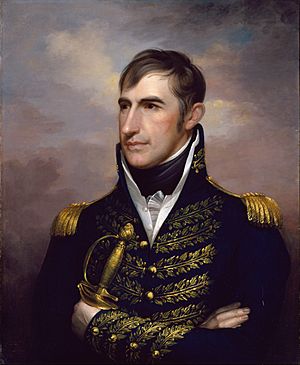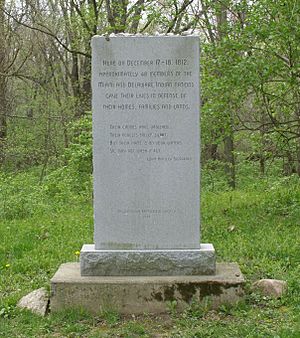Indiana in the War of 1812 facts for kids
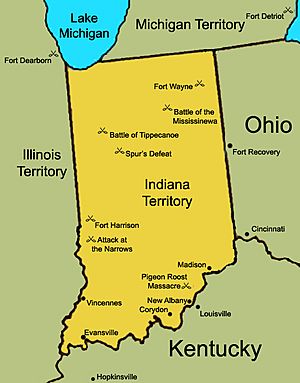
During the War of 1812, the Indiana Territory was a place of many fights. These battles happened between the United States government and Native American forces. The Native American groups were supported by the British in Canada. A big battle called the Battle of Tippecanoe happened months before the war officially started. This battle was one of the main reasons the war began. The fighting in Indiana is often seen as a continuation of Tecumseh's War. It was also the final part of a longer period of conflict known as the Sixty Years' War.
The Native American tribes who fought in these battles joined forces with the British when the war began. American forces from Indiana, Ohio, and Kentucky were led by William Henry Harrison. He later became a U.S. President. These American forces helped turn the war around, as it had started poorly for the United States. After pushing the tribal forces into Canada, the Americans invaded Canada. They defeated the British army and won the war in the Northwest.
Contents
Why the War Started in Indiana
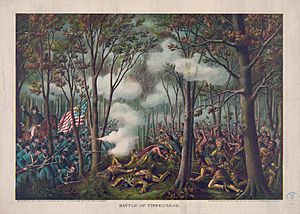
Tensions grew a lot between settlers in the Indiana Territory and Native Americans. This started after the Treaty of Fort Wayne in 1809. These rising tensions led to the Battle of Tippecanoe on November 6, 1811. This battle was part of what is known as Tecumseh's War.
In this battle, William Henry Harrison led the local militia and army soldiers. They fought against the forces of Tecumseh's confederacy at Prophetstown. Tecumseh's forces were defeated, which was a big setback for their plans for a larger uprising. However, it made the tribes look for support from outside. The British agreed to an alliance with the tribes. The conflict then joined with the larger War of 1812 the next year.
Some American leaders, like Henry Clay, were very angry at the British. They said the British were supplying weapons to the western tribes. The Battle of Tippecanoe made the relationship between the United States and Great Britain even worse. Even though Tecumseh said he wanted peace with the United States, he was secretly telling his followers to get ready for war. He also sent messages to the British, saying that Americans were gathering troops to invade Canada.
War Years: Key Events
1812: The War Begins
Just before the war officially started in June, William Henry Harrison left the territory. He was the Territorial Governor and went to get more army help. In his absence, Secretary John Gibson was in charge. When it became clear that fighting would start soon, Gibson ordered the militia to get ready. He also sent riders to tell Harrison to return quickly.
July and August were difficult for Harrison in defending Indiana. First, Chief Little Turtle died on July 14. This meant the United States lost a Native American leader they could trust for peace. Three days later, British forces took control of Lake Michigan. They captured the American fort at Mackinac Island. On August 15, the Potawatomi tribe, who were allies of the British, captured Fort Dearborn. This fort was where Chicago is today. They killed many defenders, including William Wells, who was Little Turtle's adopted son.
The British and their allies also captured Fort Detroit on August 16. This placed British forces right on Indiana's northern border. On August 18, Native Americans led by Tecumseh refused Harrison's request for a peace meeting.
With war approaching, Harrison asked for military help from nearby Kentucky. On August 22, he was made a brigadier general of the Kentucky militia. Harrison then went to gather troops to defend the Indiana government at Vincennes. Harrison had left his military job in December 1811. But with help from Kentucky Governor Charles Scott, he was able to recruit Kentuckians to help defend Indiana. People in Ohio and Indiana had heard about the lack of supplies for soldiers. They chose not to join because of these hardships.
In September, the Territorial Legislature met. They decided to move the capital from Vincennes. This was because it was too close to Native American groups. The plan was to choose a new capital and move all the important records. They stated that it was "dangerous to continue longer here on account of threatened depredations of the Indians."
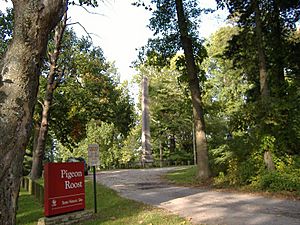
September also saw more attacks across the territory. On September 3, in northern Clark County, Shawnee warriors attacked the village of Pigeon Roost. In early September, there were separate attacks on Fort Harrison and Fort Wayne. But this time, the defenders were able to fight them off. The Siege of Fort Harrison, where Zachary Taylor led the defenders, was the first land victory for American forces in the war. It was the strongest attack the Native Americans launched against American defenders. Harrison himself helped relieve the Siege of Fort Wayne.
On September 17, Harrison was given command of all American troops in the Northwest Territories. He was ordered to retake Detroit. Throughout the second half of the month, the Miami tribe kept trying to convince the Delaware tribe to attack Americans.
American forces fought back in November. Prophetstown was destroyed again on November 22 by General Samuel Hopkins. He also attacked the empty villages of the Kickapoo and Winnebago tribes near the Tippecanoe River. The Battle of the Mississinewa saw forces under Colonel John B. Campbell attack Native Americans further. However, many of his troops suffered from frostbite. Campbell then took his men to Greenville.
The Native Americans did not get help from the British for their attacks in Indiana. A dry summer made it hard to send 600 British troops down the Maumee River to Fort Wayne.
On December 28, Harrison left his job as territorial governor. The position was not filled until Thomas Posey took office in April 1813.
1813: Rangers and Relocation
To fight the threat of Native American attacks, several groups of mounted Indiana Rangers were formed. Each group had 100 men. These soldiers did not wear uniforms and carried their own supplies. They also carried knives and long knives for fighting. These forces searched for Native American villages to get revenge for earlier attacks. There were several small fights between Native Americans and Rangers, like the Battle of Tipton's Island. But these were smaller than the big battles of 1812.
In July 1813, a large expedition left Fort Vallonia. They destroyed a well-developed Miami city where the Wabash and Mississinewa Rivers meet. However, the town was empty before the army arrived, and no Native Americans were found during the entire trip. This expedition was led by Colonel William Russell of the 7th regiment. He and 800 mounted rangers and riflemen traveled from Fort Vallonia as far north as Fort Wayne. They burned a British and Native American fort on the Wabash River. Then they traveled south to Prophetstown and set it on fire once more. The expedition then returned to Vincennes.
On May 1, 1813, the territorial legislature moved the capital to Corydon, Indiana. This town was near Kentucky and was more central to where people lived. It was also farther from the Native American groups than other possible towns.
On September 29, 1813, Harrison was able to push British forces out of Detroit. This made the British retreat into Canada. After defeating the British again at the Battle of the Thames, Harrison decided to retire to Ohio. He never lived in Indiana again.
What Happened After the War
For many years, from the American Revolutionary War until the end of the War of 1812, British agents in Canada tried to turn Native American tribes against the United States. They wanted to create a pro-British Indian barrier state to stop American expansion westward. However, in the Treaty of Ghent, Great Britain agreed not to arm or trade with Native Americans in the United States. They also dropped the idea of a barrier state.
The first ten years of the 1800s were mostly peaceful between white settlers in southern Indiana and the Native American nations. The United States wanted to gain more land for settlement. But it officially had a policy of living peacefully with the native tribes. However, after the attacks and destruction of villages from 1811 to 1813, the United States changed its policy. They adopted a removal policy, meaning they would move Native Americans from their lands.
The actions during the War of 1812 gave the United States strong control over the Indiana Territory. This led to many people settling and developing the territory quickly once peace was declared. Indiana was then admitted to the United States as a state on December 11, 1816.
|


